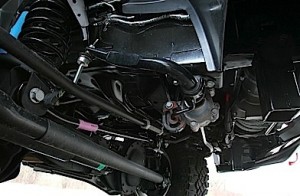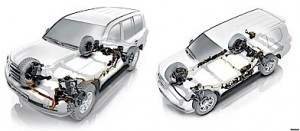Anti-Sway Bar Technology
Anti-sway bars (aka sway, stabilizer or anti-roll bars) never get the credit they deserve. If anti-sway bars were never invented, the ride and handling of vehicles would be a lot more harsh than it is today. That is because anti-sway bars act as a third spring controlling rolls stiffness of a vehicle.
An anti-sway bar has no effect if both sides simultaneously move in the same direction. If one side is moved up or down, like a dip or bump, half of the rigidity is effected. If the two sides are moving in opposite directions, like when the body sways, the full rigidity of the anti-sway bar is effected.
Imagine a car without anti-sway bars. The car would experience body roll around corners, but off-road and in a straight line, the tires would maintain better contact with rougher roads at lower speed for better traction. However, at higher speeds, the body movement around corners would negate this effect. If you increased the spring rate, it would reduce body roll but would impact ride comfort.
Now, imagine a car with over-sized anti-sway bars and lower spring rates. The car would go great around corners with very little body movement. But, during braking, the rear-to-front weight transfer would cause nosedive and squat, making it painful to drive over rough or uneven pavement.

Tuning Anti-Sway Bars
On the OEM level, the diameter of the anti-sway bar is the function of many things. Every vehicle sold must meet certain FMVSS standards for stability. This means that a new vehicle can’t be an all-out road racer or off-road rock climber with either huge anti-sway bars or none at all.
The first consideration determining anti-sway bar diameter is where the bar is located. For an anti-sway bar to be the most effective, it must attach to the control arm closest to the wheel so it has the best possible mechanical advantage for pushing the tire to the road. The length of the arms and how the bar spans the vehicle is another consideration into the diameter of the bar.
The next consideration is the roll center of the vehicle. Vehicles like trucks and vans have a higher center of gravity. This translates into a higher roll center for the suspension, which means even more body roll the anti-sway bar has to counteract.
The other consideration determining anti-sway bar diameter is the spring rates at all four corners. An engineer may want to improve the ride quality by reducing the spring rates, but this might mean a stiffer roll bar to meet stability requirements. There is a lot of give-and-take to make a vehicle that handles well but is still comfortable.
Active Roll Control
In 2001, BMW introduced active anti-sway bars made by ZF on the 7-Series. The bars actively change stiffness to control lateral weight transfer and body roll. These anti-sway bars have an adjustable torsion bar inside a housing located in the center of the bar. The torsion bar is controlled by hydraulic pressure using a hydraulic servomechanism. The system can not only adjust the bar, it can also completely disconnect the bar.
The active anti-sway bar system on these vehicles works in conjunction with the air springs and active dampening system. These components can control the suspension so there are no compromises between spring rates, dampener settings and roll bar diameter. When the vehicle is traveling in a straight line, the bar can be disconnected so each wheel can act independently to absorb bumps. When a corner is reached and steering input is detected, the bar can be engaged to stiffen up the suspension.
Toyota started implementing a similar system on some GS, LS and RX platforms in 2006. The Toyota system is different because it uses electric motors instead of hydraulics. Toyota claims its system can make a correction in less than 20 milliseconds.

Jeep’s Active Sway Bar System (SmartBar) by American Axle and Manufacturing was made available on models like the Jeep Power Wagon in 2005 and Rubicon in 2007. The system is activated by the driver, who can disconnect the front anti-sway bar without having to get out of the vehicle. The system uses an electric motor to disengage the bar. The anti-sway bar can only be disconnected if the vehicle is in 4WD and below a specific speed.
Another approach to controlling anti-sway bars is the Kinetic Dynamic Suspension System (KDSS) used by Toyota in some of its larger Lexus SUVs starting in 2004 and Land Cruisers/4Runner models starting in 2010. KDSS allows one side of the anti-sway bar mount to move independently and disengages the bar so there is more independent wheel movement.
It adjusts front and rear anti-sway bars based on a set of interconnected hydraulic cylinders. The interconnection is made up of hydraulic piping and a control cylinder which is located at the frame rail. KDSS will not engage during normal driving conditions when hydraulic pressure is equal. In off-road conditions, KDSS activates when it senses that a wheel has dropped into a rut or hits an obstacle.

Anti-Sway Bar Repair and Service Opportunities
The weakest points of any anti-sway bar system are the links that connect the bar to the suspension. Designs can vary from vertical links with bushings on both ends to full ball-and-socket joints. Both of these connections can wear over time and fail. Therefore, inspection is critical.
The anti-sway bar can break at the ends or in the middle. This type of failure is more common on smaller diameter rear anti-sway bars. Also, pay attention to the mounting bushings that attach the bar to the frame.
The repair opportunities on active anti-sway bars are increasing as vehicles age. While most of these vehicles are European nameplates, more and more domestic and Asian models are using these systems to improved stability on cars and increase off-road capabilities.













